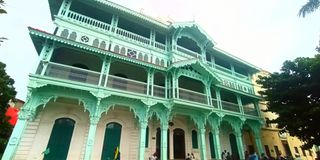Exploring stone town in Zanzibar’s spice island

The famous old dispensary at Stone Town. Photo | Pool
What you need to know:
We visited Prison Island, a government-owned tourist resort and a sanctuary for the endangered Aldabra giant tortoises some of which are aged 169 years
I recently checked Zanzibar off my bucket list destinations for 2022. I didn’t want to travel alone nor curate my travel itinerary so I used a tour company to do the heavy lifting. I shared my preferred travel dates and they came up with the perfect itinerary and crew for the seven-day trip. Our first stop was in Dar es Salaam for a night then we caught the morning ferry to Zanzibar the next day. The two-hour ferry ride experience was a nightmare for me as I got seasick and ended up sleeping while my new friends were having the time of their lives on the rooftop.
On arrival in Zanzibar, we met our guide ready to take us on the walking safari tour around Stone Town which is located on the relaxed west coast of the iconic tropical “Spice Island” of Zanzibar. The name "Stone Town" comes from the abundant use of coral stone to build their houses. It is the heartbeat and oldest town in Zanzibar city and most people assume it is the capital city of Zanzibar due to its richness in history and the many interesting architectural landmarks such as the Old Fort, The Old Dispensary, St. Joseph Cathedral, and House of wonders among others. Named a UNESCO World Heritage site in 2000, Stone Town is also known for its rich cultural heritage and it reflects the diverse influences underlying the Swahili culture giving a unique mixture of Arab, Indian, European, and Persian origin.
As we walked down the narrow alleys of Stone Town, I felt like I was back in Lamu but instead of donkeys, the streets are full of bicycles and motorbikes. The doors looked the same with intricate carvings, bas reliefs, and verandas protected by wooden balusters.

Kemzy feeding one of the giant Aldabra tortoises at Prison Island. Photo | Pool
We were ready to immerse ourselves in the deep cultural, historical, ecological, and culinary experience. Our guide informed us that Zanzibar was one of the largest slave ports in the Indian Ocean slave trade and it served as a gateway for slaves entering and exiting East Africa. At the East African Slave Trade Exhibit, we got to see the statue of five slaves bound together by a chain inside a pit and the underground chambers where slaves were kept before being sold off. The slave monument was created by Clara Sornas as a ‘memory for the slaves’ in 1998 and serves as a reminder of the atrocities suffered by the victims of the East African slave trade.
Moving on from the sad history we visited the Old Fort which is a hefty stone fortress built by the Omanis in the 17th century to prevent the city from European invasions. It is currently being used as a cultural Centre and an amphitheater by locals to showcase live dances and entertainment.
Just adjacent to the Old Fort on the seafront is the House of Wonders also known as the Palace of wonders which was the first building in Zanzibar to have electricity and the first one in East Africa to have an elevator. At night, locals used to assemble outside the palace to witness the Sultan turn on the lights and cheer. What a time to be alive! The palace has since then been renovated into a museum for Zanzibar and Swahili culture. It is one of the most popular landmarks in Stone Town.

The famous old dispensary at Stone Town. Photo | Pool
We also visited the palace museum, old dispensary, and St. Joseph cathedral church before taking a twenty-minute boat ride to Prison Island which is an island that was meant to jail rebellious slaves but was turned into a yellow fever quarantine site as no slaves were imprisoned there. It has very clean white sandy beaches and is less crowded. Currently, it is a government-owned tourist resort and a sanctuary for the endangered Aldabra giant tortoises some of which are as old as 169 years and weigh over 200kilograms. It was an interesting scene to feed these gigantic creatures.
Our last stop was the Forodhani Market which is the pinnacle of the Stone Town tour. The market comes alive at sunset with different food vendors displaying their meals for tourists and locals until late into the night. This is the place to get the most affordable seas food platters and local delicacies. We tried out almost every single dish and our favourites were the chicken tikka, Zanzibar pizza, kaimati, chips mayai, shawarmas, octopus, and lobsters.
Keep it here for more Zanzibar stories.




